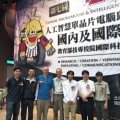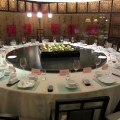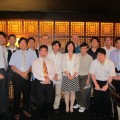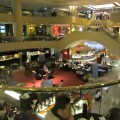 Day two was Sunday September 25th – contest day at the 2011 Taiwan Micromouse and Intelligent Robotics Contest. After an intense period or preparation with the re-write of nearly all the code on on my mouse, it was time to put it all to the test…As invited guests to the contest, we played an integral part in the day’s activities. It was an honour to be included in such an auspicious line-up. As we took our places on the stage for the opening ceremony, I felt a little overawed to be in the company of some of the most famous and respected mouse builders in the world.
Day two was Sunday September 25th – contest day at the 2011 Taiwan Micromouse and Intelligent Robotics Contest. After an intense period or preparation with the re-write of nearly all the code on on my mouse, it was time to put it all to the test…As invited guests to the contest, we played an integral part in the day’s activities. It was an honour to be included in such an auspicious line-up. As we took our places on the stage for the opening ceremony, I felt a little overawed to be in the company of some of the most famous and respected mouse builders in the world.
Contest nerves and the general excitement in the hall soon took my mind of all of that as we took the opportunity to get in a final practice session during the morning. Decimus – now Decimus 2A in honour of the re-write – was still behaving oddly. The business of the forward facing sensors that I noticed the previous day began to look as if the needed to warm up some how. This was not a sensible notion for IR leds but that was how it seemed. For the first few minutes, these sensors would not give reliable results. After a short while, they appeared to settle down and behave themselves again. This was a great puzzle and did not bode well. In the end, I managed to iron out a number of other small bugs and had the mouse running reasonably well. the practice maze had a path of 66 cells and, on its slowest fast run speed, Decimus 2A managed 10.4 seconds. previous practice showed that it could increase performance by at least 50% over that so I was reasonably happy.
 Once the practice was out of the way, I could watch some of the other contests. As ever at contests, there is just too much going on to see it all and I spent much of my time watching the line followers. This is an event that fascinates me. It looks like it should be easy enough but the evidence of the huge number of entries was that it was anything but easy. I would guess there were over 100 entries to this contest – many of them based on a kit from Innovati. The most common approach was for a wheelchair chassis and fixed sensors. The greatest variation for kit entries was in the choice of tyres. As well as the local classes, there was an invitational event where the best of the Taiwanese line-followers were up against entries from Ng Beng Kiat of Singapore and Hirai Masataka of Japan.
Once the practice was out of the way, I could watch some of the other contests. As ever at contests, there is just too much going on to see it all and I spent much of my time watching the line followers. This is an event that fascinates me. It looks like it should be easy enough but the evidence of the huge number of entries was that it was anything but easy. I would guess there were over 100 entries to this contest – many of them based on a kit from Innovati. The most common approach was for a wheelchair chassis and fixed sensors. The greatest variation for kit entries was in the choice of tyres. As well as the local classes, there was an invitational event where the best of the Taiwanese line-followers were up against entries from Ng Beng Kiat of Singapore and Hirai Masataka of Japan.
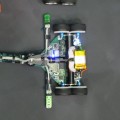 In Japan, there has been a history of entries that use a steered array of sensors and that was what we saw today. The basic chassis is a wheelchair design, driven and steered by the same wheels (four of course). The sensors, however were clustered quite close together and mounted on a long arm attached to a custom built servo. In operation, the servor keeps the sensors over the line and the rest of the robot follows along. This is a very effective technique. In particular, the line sensors behave as if running in rails and I don’t think I saw them deviate from the line at all.
In Japan, there has been a history of entries that use a steered array of sensors and that was what we saw today. The basic chassis is a wheelchair design, driven and steered by the same wheels (four of course). The sensors, however were clustered quite close together and mounted on a long arm attached to a custom built servo. In operation, the servor keeps the sensors over the line and the rest of the robot follows along. This is a very effective technique. In particular, the line sensors behave as if running in rails and I don’t think I saw them deviate from the line at all.
All the robots in the final stages of this event were very fast. A characteristic of the event is that each robot has a limited time to run in. The first task is to go around the circuit and learn where the features are. Then it is possible to do a speed run based upon what has been learnt. Since there is unlikely to be time to do more than one or two speed runs, the builder has to decide how hard to push the robot. Crashing is clearly not good but it is not possible to take several attempts and ramp up the speed each time. Today, the contest was won by Hirai-san with a very impressive run. With that all done, Ng Beng Kiat asked if he could take another run to see if he could have pushed a bit harder. This would not have changed the result – he was simply curious. His new time was indeed faster than that posted by Hirai-san’s robot. Not to be outdone, Hirai-san too had another go and posted an even faster time.
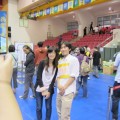 By now there was a considerable excitement around the arena and Ng Beng Kiat rose to the challenge with another attempt. This time, Beng Kiat could not get around any faster and Hirai-san was content to let things rest. All this had everyone so excited that I wonder if a series of runs, one after the other in a last-man-standing event might not be the way to go. Hirai-san’s win made him an instant hit and more than one young lady had to have a picture taken with him.
By now there was a considerable excitement around the arena and Ng Beng Kiat rose to the challenge with another attempt. This time, Beng Kiat could not get around any faster and Hirai-san was content to let things rest. All this had everyone so excited that I wonder if a series of runs, one after the other in a last-man-standing event might not be the way to go. Hirai-san’s win made him an instant hit and more than one young lady had to have a picture taken with him.
The time came to take part in the classic micromouse event. Having had the earlier issues with the sensors, I decided to turn the mouse on when the previous entry started in the hope that things would settle down by the time I had to run. Unfortunately, that didn’t do it and Decimus 2A crashed within a couple of cells of the start. The Taiwan rules allow a limited time and only five runs and that was the first run written off. The next run was also unsuccessful as the mouse once again ran into a wall ahead. This was the exact symptom that I had been afraid of. Once again though, after a couple of minutes actual running, everything settled down and I was able to do an exploration run in just under 96 seconds. With the better mice achieving exploration times nearer 60 seconds, I clearly need to increase the explore speed. By now, Decimus seemed to be running reasonably well but, with only two runs left and very short time available, I crashed out on both and failed to improve my time. I was in reasonably good company though with three other mice out of the field of 12 unable to complete a speed run.
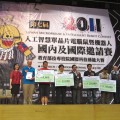 The best score was obtained by Ng Beng Kiat with a remarkable 8.14 seconds. While this may seem slow compared to times posted at the Japan contests, remember that there is a search time penalty and that this maze had a solution that was about 98 cells long compared to a typical Japanese contest maze where the path is about 65 cells in length. As ever, it was a real treat to see these exceptional mice race around the maze.
The best score was obtained by Ng Beng Kiat with a remarkable 8.14 seconds. While this may seem slow compared to times posted at the Japan contests, remember that there is a search time penalty and that this maze had a solution that was about 98 cells long compared to a typical Japanese contest maze where the path is about 65 cells in length. As ever, it was a real treat to see these exceptional mice race around the maze.
After the contests was the prize giving and a whole buch of relieved and, presumably, happy contestants. I say presumably since some of them seemed to be very nervous about being on stage. there had been a performance planned by by a band as part of the closing ceremony but, since we were running a little late, they were cancelled. I felt really sorry for them although we never even got to see who they were.
There is no doubt that the Taiwanese are excellent hosts. After everything was sorted out from the contest, we were taken off to a very impressive dinner, hosted by the Taiwan Minister for Education and a a private dining room at a large hotel in the centre of Taipei. Taiwanese formal dinners are pretty wondrous with many courses of excellent food. Frequent toasts, great company and an apparently endless supply of treats finished the day off rather well. Almost the only time the room was quite was when, half way through the meal, a course consisting of a half lobster arrived and demanded everyone’s full attention.
